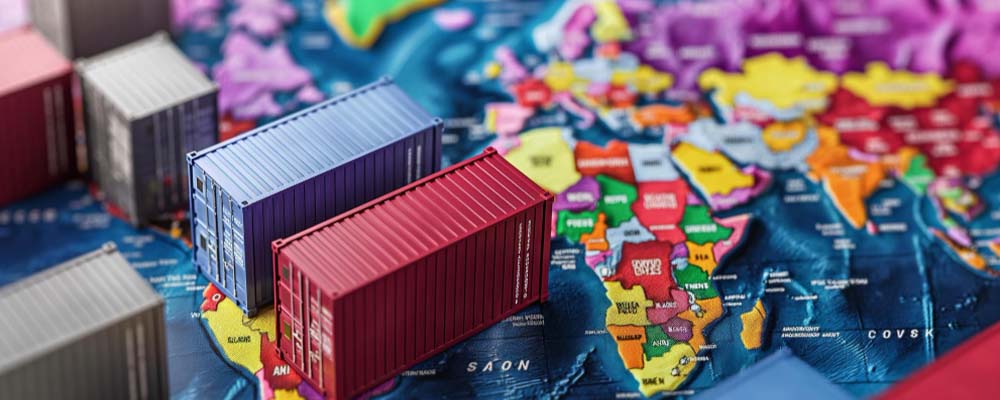
It effectively handles a variety of cargo types.Shipping a container to New Zealand can be a complex endeavor, whether you’re a seasoned freight forwarder, a burgeoning e-commerce business, or an international manufacturer. With its remote location and unique import requirements, understanding the nuances of shipping to this island nation is crucial for smooth operations. In this guide, we’ll walk you through everything you need to know to successfully ship containers to New Zealand, from costs and transit times to selecting the right logistics partners.
What Are the Ways to Ship to New Zealand?
When it comes to shipping containers to New Zealand, there are primarily two modes of transport: sea freight and air freight. While each has its advantages, the choice ultimately depends on your specific needs and constraints.
Sea Freight
Sea freight is the most common and cost-effective way to ship containers to New Zealand. It’s particularly suitable for bulky or heavy shipments that are not time-sensitive. Large cargo vessels typically ship containers, which can be either full container loads (FCL) or less-than-container loads (LCL).
Air Freight
While significantly more expensive than sea freight, air freight offers unbeatable speed. This option is ideal for high-value or perishable goods that require quick delivery. However, it’s important to consider the weight and volume limitations of air freight, as it may not be suitable for all types of cargo.
Intermodal Transport
Intermodal transport combines sea and air freight, offering a balanced solution for cargo that needs faster delivery without the high cost of full air freight. This method can be particularly useful for businesses looking to optimize their supply chain efficiency.
 What Are the Costs to Ship a Container to New Zealand?
What Are the Costs to Ship a Container to New Zealand?
Shipping costs to New Zealand can vary widely based on several factors. Understanding these variables will help you better estimate your shipping expenses.
Distance and Route
The distance between the origin and destination ports plays a significant role in determining shipping costs. Direct routes are generally cheaper, but depending on the shipping lanes, indirect routes might sometimes be unavoidable.
Container Size and Type
Standard containers come in 20-foot and 40-foot sizes. Specialized containers, like refrigerated or open-top containers, can incur additional costs. The type of cargo also influences the overall price.
Additional Charges
Aside from the base shipping rates, there are several additional charges to consider, including port fees, handling fees, and customs duties. These costs can accumulate rapidly, so it’s essential to account for them in your budget.
What is the Transit Time When Shipping to New Zealand?
Transit times can vary depending on the mode of transport and the origin of the shipment. Here’s a general overview to help you plan better.
Sea Freight Transit Times
For sea freight, transit times can range from 20 to 40 days, depending on the departure port. For instance, shipments from the west coast of the United States typically take around 20 to 25 days, whereas shipments from Europe can take up to 40 days.
Air Freight Transit Times
Air freight offers much shorter transit times, generally between 3 to 10 days. However, this does not account for potential delays during customs clearance and handling at both the origin and destination airports.
Influencing Factors
Several factors can influence transit times, including weather conditions, port congestion, and shipping lane traffic. It’s always advisable to plan for potential delays and keep your customers informed.
 Main Ports in New Zealand
Main Ports in New Zealand
New Zealand boasts several major ports that facilitate international trade. Knowing these ports can help you determine the best entry point for your shipment.
Port of Auckland
The Port of Auckland is the largest and busiest port in New Zealand, handling a significant portion of the country’s imports and exports. It offers extensive facilities and services, making it a preferred choice for many shippers.
Port of Tauranga
Located in the Bay of Plenty, the Port of Tauranga is another major hub for container shipping. Its deep-water capabilities and efficient handling services make it ideal for large-scale shipments.
Port of Wellington
While smaller than Auckland and Tauranga, the Port of Wellington is strategically located in the capital city, serving as a crucial gateway for imports and exports. It effectively handles a variety of cargo types.
How Do I Find a Freight Forwarder in New Zealand?
Selecting a reliable freight forwarder is crucial for a seamless shipping experience. Here are some tips to help you find the right partner.
Research and Reviews
Start by researching freight forwarding companies with a strong presence in New Zealand. Seek out reviews and testimonials from other businesses to assess their reliability and service quality.
Industry Expertise
Choose a freight forwarder with expertise in your industry. They will handle specific challenges and requirements related to your cargo more effectively.
Licensing and Certifications
Ensure that the freight forwarder is properly licensed and certified by relevant authorities. This adds an extra layer of credibility and assurance that they adhere to industry standards.
FAQs about Shipping Your Container to New Zealand
To deepen your understanding, we have provided answers to some frequently asked questions.
How to Determine Shipping Costs to New Zealand?
Shipping costs are determined by a combination of factors such as distance, container size, type, and additional charges. Request quotes from multiple freight forwarders to get an accurate estimate.
What Type of Cargo Can Be Sent in a Container?
Almost any type of cargo can be sent in a container, including electronics, clothing, machinery, and perishable goods. It’s essential to choose the right container type that suits your cargo’s specific needs.
What Documentation is Required for International Shipments to New Zealand?
International shipments require several documents, including a bill of lading, commercial invoice, packing list, and customs declaration. Ensure all paperwork is accurately completed to avoid delays.
 Conclusion
Conclusion
Shipping containers to New Zealand might seem daunting, but with the right preparation and knowledge, it can be a smooth and efficient process. By understanding the various shipping methods, costs, and transit times, you can make informed decisions that benefit your business operations. Don’t forget the importance of selecting a reputable freight forwarder to ensure your cargo arrives safely and on time.
Ready to streamline your shipping to New Zealand? Start by engaging with our trusted partners who can offer expert advice and tailored solutions to meet your specific needs. Together, we can make your shipping experience seamless and stress-free.




 What Are the Costs to Ship a Container to New Zealand?
What Are the Costs to Ship a Container to New Zealand? Main Ports in New Zealand
Main Ports in New Zealand Conclusion
Conclusion



